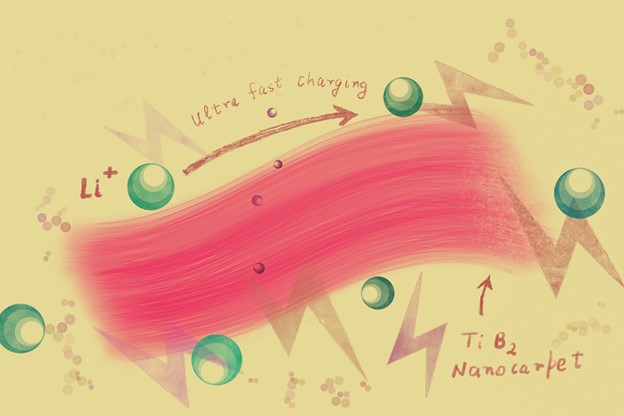
New material may hold promise for more efficient lithium-ion batteries

Indian researchers have discovered a new anode material which could be helpful in ensuring the life and fast charging of lithium-ion batteries (LIBs). This discovery could help charge battery-based devices and electric vehicles (EVs) at ultra-fast speeds.
The study was carried out by researchers from the Indian Institute of Technology (IIT) Gandhinagar in collaboration with the Japan Advanced Institute of Science and Technology (JAIST).
The new two-dimensional (2D) anode material is developed using Nano sheets derived from titanium diboride (TiB2) which resemble a stack of sandwiches where metal molecules exist between layers of boron. This innovation has the potential for translation from lab to real-life application, said researchers.
LIBs have the anode material as the negative electrode which is attached to the cathode material in the Li-ion battery cell. The anode materials in a lithium-ion cell act as the host, enabling lithium-ion intercalation/de-intercalation during the battery’s charge or discharge cycle.
LIBs with Graphite anode, extremely energy dense, can power an electric vehicle for hundreds of kilometers on a single charge. However, it has its challenges on the safety front as they are prone to fire hazards.
Also Read: 3 awarded Chemistry Nobel for developing lithium ion batteries
Lithium Titanate anodes are safer and more preferred alternatives and they also facilitate fast charging. But, they have a lower energy density so they would need more frequent recharging.
Anode material is the negative electrode in lithium-ion batteries and is paired with cathode material in a lithium-ion battery cell. The anode materials in lithium-ion cells act as the host where they reversibly allow lithium-ion intercalation/de-intercalation during charge or discharge cycles.
Li-Ion batteries enabled by nanosheets based anode material have an edge as they offer ultra-fast charging time (full charge within minutes), long life cycle (10,000 cycles at high charge currents), and nanosheets used to prepare the anode have a high density of pores.
While the planar nature and chemistry of nanosheets provide a high surface area for catching hold of Li-ions, the pores enable better diffusion of ions.
The research team led by Prof. Kabeer Jasuja (from IITGN) and Prof. Noriyoshi Matsumi (JAIST) found that when Titanium Diboride (TiB2)-based Hierarchical Nanosheets (THNS) were used to prepare the anode, it exhibited a discharge capacity of 174 mA h/g (a unit that measures the energy capacity of a battery) that can be obtained at a current rate of 1 A/g within ten minutes.
Also Read: Govt allows sale, registration of electric vehicles without pre-fitted batteries
The intertwined carpet-like structure facilitates an efficient migration of charges in and out of nanosheets easily, which resolves a Lithium-Ion diffusion-related challenge.
They also found that this anode had an ultra-fast charging capacity with a considerable discharge capacity at high-capacity retention (up to 80 per cent even after 10,000 cycles of operation), which means that batteries made with this material would give almost the same high performance even after more than 10,000 cycles of charging.
Moreover, there was no degradation or corrosion of THNS due to redox reactions, the porosity is also retained very well, and it demonstrates structural stability with less volumetric expansion (less than 40 per cent) over thousands of charge−discharge cycles.
Akash Varma, an MTech student, the first author of the study, said, “It is the presence of titanium and boron atoms arranged in a carpet-like interweaved porous structure within the nanosheets that are helping in an efficient charge transport and storage.”
He spent one year at IITGN and another year at JAIST as a part of his double master’s degree, a unique collaborative programme between JAIST and IITGN.
Also Read: Science and tech focus helps India shine, propels nation toward 2047
Prof. Kabeer Jasuja, Dr. Dinesh O Shah Chair Associate Professor of Chemical Engineering, IITGN, said, “What makes this work especially useful is the fact that the method to synthesise TiB2 nanosheets is inherently scalable. It only requires mixing the TiB2 particles in an aqueous solution of dilute hydrogen peroxide and allowing it to recrystallise.
For any nanomaterial to translate into a tangible technology, scalability is the limiting factor. Our method to synthesise these TiB2 nanosheets only requires stirring and no sophisticated equipment, making it highly adoptable.”
This collaborative study was recently published in the journal ACS Applied Nanomaterials.

